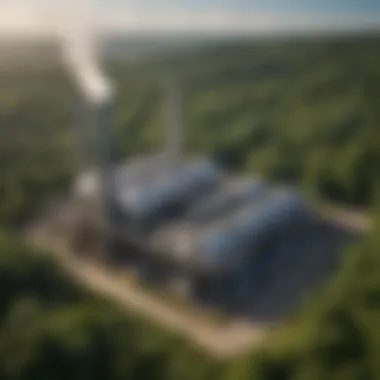Innovative Solutions for Carbon Capture and Environmental Conservation


Evergreen Trees Species
Evergreen trees play a vital role in carbon sequestration and ecosystem preservation. There is a diverse range of evergreen tree species flourishing in American forests, each contributing uniquely to the environment. From majestic Sequoias to resilient Pines, the variations in types of evergreen trees are a testament to nature's biodiversity.
Types of Evergreen Trees:
American forests boast a plethora of evergreen tree species, including iconic representatives like Redwoods, Spruces, and Firs. These trees not only offer visual beauty but also serve as carbon sinks, absorbing carbon dioxide and releasing oxygen.
Ecological Significance:
The ecological significance of evergreen trees cannot be overstated. These trees provide habitat and food for numerous wildlife species, contribute to soil stability, and play a crucial role in regulating the climate. Their year-round foliage ensures a constant source of oxygen production and carbon sequestration.
Conservation Practices:
To safeguard the longevity of evergreen tree species, conservation practices are paramount. Measures such as protected areas, controlled logging, and reforestation initiatives are implemented to ensure the preservation of these invaluable resources.
Forest Management Techniques
Forests require meticulous management to thrive sustainably and support diverse ecosystems. Effective forest management involves a holistic approach that considers wildlife preservation, sustainable logging practices, fire prevention, and ecosystem restoration.
Wildlife Habitat Preservation:
Preserving wildlife habitats within forests is essential for maintaining biodiversity and ecosystem balance. Strategies such as habitat corridors, protected areas, and species monitoring aid in safeguarding the diverse flora and fauna that depend on these ecosystems.
Sustainable Logging Practices:
Sustainable forestry operations focus on responsible timber harvesting methods that minimize environmental impact and promote forest regeneration. Selective logging, tree planting programs, and adherence to industry guidelines ensure the long-term health of forest ecosystems.
Fire Prevention Measures:
Forest fires pose a significant threat to woodland ecosystems and wildlife populations. Implementing fire prevention measures such as controlled burns, firebreaks, and early detection systems plays a crucial role in protecting forests and minimizing fire-related damages.
Ecosystem Restoration Initiatives:
In degraded forest lands, ecosystem restoration initiatives are vital for rejuvenation and sustainability. Through reforestation projects, soil conservation efforts, and invasive species removal, degraded ecosystems can be rehabilitated to support healthy and resilient habitats.
Climate Change Impact on Evergreen Forests
Climate change has profound implications for evergreen forests, affecting key processes such as carbon sequestration, weather patterns, biodiversity, and ecosystem dynamics. Understanding these impacts is essential for implementing adaptive strategies and conservation measures.
Carbon Sequestration:
Evergreen forests are critical contributors to carbon sequestration, absorbing and storing vast amounts of carbon dioxide. By protecting and expanding these forested areas, significant carbon offsets can be achieved, mitigating the impacts of climate change.
Weather Pattern Effects:
Climate change alters weather patterns in forested regions, leading to shifts in temperature, precipitation, and extreme weather events. These changes impact ecosystem functions, wildlife behavior, and overall forest health, highlighting the interconnected nature of climate and forests.
Biodiversity Support:


Climate change poses challenges to biodiversity within evergreen forests, affecting species distributions, migration patterns, and habitat suitability. Conservation efforts that focus on preserving diverse ecosystems and creating climate-resilient habitats are essential for safeguarding biodiversity.
Localized Effects:
The regional impacts of climate change on evergreen forests vary geographically, influencing local communities and ecosystem services. Understanding these localized effects is crucial for developing region-specific conservation strategies and adaptive management practices.
Management and Preservation of Evergreen Forests
The management and preservation of American evergreen forests require a balanced approach that integrates historical context, research findings, and conservation efforts. By learning from the past, embracing scientific advancements, and engaging in proactive conservation initiatives, the long-term health of evergreen landscapes can be secured.
Historical Context:
Exploring the historical context of American evergreen forests offers valuable insights into native practices, land use patterns, and ecological transformations over time. By understanding the historical trajectory of these landscapes, present-day conservation strategies can be informed and enhanced.
Research Findings:
Contemporary research findings shed light on the biodiversity, ecosystem services, and carbon dynamics within evergreen forests. Through cutting-edge studies and monitoring programs, researchers are uncovering new knowledge that guides conservation efforts and informs sustainable management practices.
Conservation Efforts Showcase:
Ongoing conservation initiatives showcase the dedication and collaboration among stakeholders to protect and preserve American evergreen landscapes. Success stories rooted in community engagement, scientific innovation, and policy support demonstrate the tangible outcomes of concerted conservation efforts.
Outdoor Activities in Evergreen Forests
Apart from their ecological significance, evergreen forests offer recreational opportunities for nature enthusiasts and outdoor adventurers. From tranquil hiking trails to picturesque camping destinations, these natural settings provide a platform for exploration, connection with nature, and outdoor recreation.
Hiking Trails Exploration:
Embark on a journey through serene hiking trails that wind through evergreen forests, offering a blend of scenic vistas, diverse wildlife encounters, and immersive nature experiences. Whether seeking a leisurely stroll or a challenging hike, these trails cater to outdoor enthusiasts of all levels.
Camping Destinations:
Discover secluded camping spots nestled within American evergreen forests, where the sights and sounds of nature create a peaceful retreat for camping enthusiasts. From traditional tent camping to modern RV facilities, these destinations provide a back-to-nature experience surrounded by forested beauty.
Nature Photography Opportunities:
Capture the breathtaking beauty of evergreen landscapes through nature photography, showcasing the intricate details of flora, fauna, and natural features found in these forested environments. Explore prime photography spots that offer unique perspectives and lighting conditions for creating stunning visual narratives.
Birdwatching Enthusiasts:
Immerse yourself in the symphony of bird songs echoing through evergreen trees, as prime birdwatching areas provide a sanctuary for avian species of all kinds. From elusive migratory birds to resident songbirds, these forested habitats attract birdwatching enthusiasts seeking moments of tranquility and avian observation.
Introduction
In the comprehensive exploration of methods to capture carbon for environmental conservation, it is imperative to understand the pivotal role that efficient carbon sequestration plays in mitigating climate change and preserving our ecosystem. The sophisticated techniques and nature-based solutions available for carbon capture are essential for combatting the adverse impacts of greenhouse gas emissions on our planet. By delving into this topic, we aim to shed light on the significance of adopting sustainable practices to safeguard the environment for current and future generations.
Understanding Carbon Capture
The Importance of Carbon Sequestration
Carbon sequestration stands at the forefront of strategies aimed at reducing the concentration of CO2 in the atmosphere, directly contributing to the stabilization of global temperatures. Its ability to trap carbon dioxide and prevent its release into the atmosphere is a crucial factor in the fight against climate change. The concept of carbon sequestration not only aids in improving air quality but also fosters a healthier environment by curbing the greenhouse effect. While it presents promising benefits for environmental conservation, challenges such as long-term storage viability and monitoring processes need continuous refinement to maximize its efficacy.


Impact of Carbon Emissions on Climate Change
The repercussions of excessive carbon emissions on climate change are profound and far-reaching, underscoring the urgent need for carbon capture initiatives. The consistent release of CO2 into the atmosphere intensifies the greenhouse effect, leading to higher global temperatures, altered weather patterns, and rising sea levels. Understanding the detrimental impact of carbon emissions underscores the critical importance of implementing robust strategies for carbon capture and storage. By addressing the root cause of climate change through effective carbon sequestration measures, we can steer towards a more sustainable future.
Significance of Capturing Carbon
Role in Mitigating Global Warming
Capturing carbon plays a pivotal role in mitigating the adverse effects of global warming by reducing the volume of greenhouse gases in the atmosphere. By capturing and storing CO2 emissions before they reach the atmosphere, we can actively lower the carbon footprint and combat the escalating threats posed by climate change. The integration of carbon capture technologies into various industries proves to be instrumental in achieving emission reduction targets and fostering a greener economy. While the implementation of these technologies requires initial investments, the long-term benefits in terms of environmental preservation and climate resilience outweigh the costs.
Contribution to Environmental Sustainability
The practice of capturing carbon not only aids in mitigating climate change but also contributes significantly to enhancing environmental sustainability on a global scale. By capturing and utilizing CO2 emissions for productive purposes such as enhanced oil recovery or bioenergy generation, we can effectively reduce the ecological footprint associated with industrial activities. Furthermore, incorporating carbon capture technologies into existing infrastructure promotes resource efficiency and aligns industry practices with sustainable development goals. Fostering a culture of environmental stewardship through carbon capture initiatives fosters a harmonious balance between ecological preservation and economic growth.
Natural Methods
In the discourse surrounding the best methods to capture carbon for environmental conservation, the emphasis on natural solutions like afforestation and reforestation plays a vital role. These methods, rooted in leveraging nature's inherent capacity for carbon sequestration, offer an organic and sustainable approach to combating climate change. The focus on natural methods aligns with the harmonization of human activities with natural ecosystems, striving for a balance that fosters both environmental health and carbon mitigation strategies.
Afforestation and Reforestation
Enhancing Forest Cover for Carbon Sequestration
The specific facet of enhancing forest cover for carbon sequestration underscores the practice of strategically planting trees and reviving forested areas to enhance their carbon absorption capabilities. This initiative is crucial in bolstering the Earth's natural carbon sinks, thereby aiding in the reduction of greenhouse gas concentrations in the atmosphere. The key characteristic of enhancing forest cover lies in its ability to not only sequester carbon effectively but also promote biodiversity, enhance soil health, and mitigate the impacts of deforestation. By actively increasing forest cover, this method stands out as a practical and widely acclaimed choice within the realm of carbon sequestration efforts.
The unique feature of enhancing forest cover for carbon sequestration is its multifaceted benefits, including mitigating the effects of climate change, preserving wildlife habitats, and fostering sustainable forestry practices. However, challenges such as land availability, maintenance costs, and long-term monitoring necessitate careful considerations when implementing this approach in the context of the broader environmental conservation landscape.
Benefits of Tree Planting for Climate Action
The benefits of tree planting for climate action encapsulate the positive outcomes derived from widespread tree cultivation initiatives aimed at carbon capture and environmental restoration. This practice not only aids in reducing carbon dioxide levels but also contributes to enhancing air quality, conserving water resources, and promoting overall ecological resilience. The crux of this aspect lies in the pivotal role that forests and trees play in mitigating climate change through their capacity to sequester carbon and regulate microclimates.
The unique feature of tree planting for climate action lies in its scalability and adaptability across diverse landscapes, allowing for targeted interventions in areas prone to deforestation, desertification, or environmental degradation. While this approach boasts numerous advantages such as carbon sequestration, ecosystem restoration, and community engagement, potential drawbacks may include the time required for trees to reach maturity, susceptibility to disease or pests, and the need for ongoing maintenance efforts.
Soil Carbon Sequestration
In the realm of natural carbon capture methods, soil carbon sequestration stands out as a fundamental approach to promoting carbon storage within terrestrial ecosystems. This process involves enhancing soil health and fertility to maximize its capacity for retaining carbon, thereby mitigating greenhouse gas emissions and supporting sustainable agricultural practices. The attention given to soil carbon sequestration underscores its integral role in carbon cycling processes, ecosystem functioning, and climate change mitigation efforts.
Promoting Soil Health for Carbon Storage
The specific focus on promoting soil health for carbon storage highlights the significance of implementing practices that enhance soil structure, nutrient content, and microbial activity to facilitate carbon sequestration. By improving soil health, organic matter decomposition rates can be optimized, leading to increased carbon retention in the soil profile. The key characteristic of this approach lies in its ability to not only sequester carbon but also enhance soil fertility, water retention capacity, and overall land productivity.
The unique feature of promoting soil health for carbon storage is its synergistic benefits for both climate change mitigation and agricultural sustainability. While advantages include improved soil structure, enhanced crop yields, and reduced reliance on chemical inputs, challenges such as management complexity, site-specific considerations, and long-term monitoring requirements underscore the need for targeted strategies tailored to diverse environmental contexts.
Impact of Agricultural Practices on Carbon Capture
The impact of agricultural practices on carbon capture delves into the influential role of farming techniques, land management strategies, and crop rotations in determining the carbon sequestration potential of agricultural landscapes. By optimizing agricultural practices to prioritize carbon storage in soils, farmers can actively contribute to climate change mitigation while ensuring sustainable food production systems. The consideration given to this aspect underscores the interplay between land use practices, soil health management, and carbon sequestration outcomes.
The key characteristic of the impact of agricultural practices on carbon capture lies in its direct correlation to soil organic carbon levels, greenhouse gas emissions, and land-use change dynamics. By adopting conservation tillage, cover cropping, agroforestry, and other sustainable practices, farmers can enhance carbon sequestration, soil resilience, and ecosystem services. However, challenges such as knowledge dissemination, policy support, and economic incentives highlight the need for holistic approaches that integrate agricultural productivity with carbon capture objectives.
Technological Innovations


Technological innovations play a pivotal role in the realm of carbon capture and this article explores the significance of these advancements in combatting climate change. These innovations bring cutting-edge solutions to the forefront, revolutionizing the methodologies employed for carbon sequestration. By delving into the intricate mechanisms and efficacy of these technologies, a deeper understanding of their impact is unveiled.
Carbon Capture and Storage (CCS)
Mechanism of Carbon Capture Technology
The mechanism of carbon capture technology involves the extraction of carbon dioxide emissions from industrial processes before they are released into the atmosphere. This process encompasses various techniques such as absorption and adsorption to capture CO2 effectively. The key characteristic of this technology lies in its ability to reduce carbon emissions significantly, thereby mitigating the adverse effects of greenhouse gases. Its uniqueness stems from its capacity to trap CO2 and prevent it from entering the environment. While advantageous in reducing carbon footprints, challenges such as high costs and scalability issues need to be addressed for widespread implementation.
Challenges and Opportunities in CCS Implementation
The implementation of Carbon Capture and Storage (CCS) presents both challenges and opportunities in the fight against climate change. One of the primary challenges lies in the technological complexity and energy requirements associated with CCS. Despite these hurdles, CCS offers significant opportunities for carbon reduction by capturing emissions from power plants and industrial sources. Additionally, CCS can facilitate the decarbonization of various sectors, opening up avenues for sustainable development. However, the integration of CCS into existing infrastructure necessitates careful planning and investment to overcome barriers and maximize its potential.
Direct Air Capture (DAC)
Utilizing Air Capture Devices for CO2 Removal
Direct Air Capture (DAC) technology involves extracting carbon dioxide directly from the ambient air using specialized chemical processes. The key characteristic of DAC lies in its ability to capture CO2 emissions from diffuse sources, aiding in the reduction of atmospheric carbon levels. Its unique feature allows for the removal of CO2 without being location-dependent, offering flexibility in implementation. Despite its advantages in directly addressing carbon emissions, DAC faces challenges related to energy consumption and cost-effectiveness, signaling areas for further refinement.
Feasibility of DAC in Carbon Sequestration
The feasibility of DAC in carbon sequestration hinges on its potential to complement existing carbon capture efforts and contribute to global emission reduction targets. This aspect underscores DAC's role in enhancing carbon removal strategies and bolstering mitigation initiatives. The unique feature of DAC lies in its ability to operate independently of emission sources, paving the way for decentralized carbon removal solutions. While offering promise in advancing carbon sequestration practices, DAC encounters challenges in scalability and operational efficiency, necessitating continuous innovation to optimize its effectiveness.
Biological Approaches
Ocean-Based Carbon Sequestration
Utilizing Marine Ecosystems for Carbon Absorption
When delving into the specific aspect of Utilizing Marine Ecosystems for Carbon Absorption, it becomes apparent that oceans act as crucial carbon sinks, absorbing vast amounts of carbon dioxide from the atmosphere. This natural process aids in regulating carbon levels and mitigating climate change impacts. The key characteristic of utilizing marine ecosystems lies in their ability to sequester carbon on a large scale, contributing significantly to the overall goal of carbon capture and environmental conservation. Despite this, challenges such as ocean acidification and potential disruptions to marine ecosystems must be carefully considered in the context of this article, shedding light on both the advantages and disadvantages of relying on ocean-based carbon sequestration.
Effectiveness of Ocean Afforestation
Another crucial aspect explored within the biological realm is the Effectiveness of Ocean Afforestation. This innovative approach involves planting marine vegetation like seaweed to enhance carbon absorption in coastal areas. The key characteristic of this method lies in its ability to not only sequester carbon but also promote marine biodiversity and ecosystem health. Ocean afforestation emerges as a promising choice for carbon capture efforts due to its sustainable nature and potential for long-term carbon storage. However, challenges such as scalability and monitoring effectiveness pose as considerations within the scope of this article, allowing for a nuanced discussion on the advantages and disadvantages of incorporating ocean afforestation in carbon sequestration strategies.
Bioenergy with Carbon Capture and Storage (BECCS)
Combining Energy Production with Carbon Removal
In the domain of Bioenergy with Carbon Capture and Storage (BECCS), the emphasis lies on Combining Energy Production with Carbon Removal to achieve dual objectives of energy generation and carbon sequestration. This symbiotic relationship between generating bioenergy while capturing and storing carbon showcases a sustainable approach towards mitigating climate change impacts. The key characteristic of BECCS implementation is its ability to integrate carbon removal technologies with existing energy production systems, thereby fostering a more eco-friendly energy sector. By providing a viable solution for carbon mitigation and renewable energy production, Combining Energy Production with Carbon Removal stands out as both a beneficial and popular option within the context of this article.
Sustainable Practices in BECCS Implementation
Additionally, Sustainable Practices in BECCS Implementation further enhance the overall effectiveness of bioenergy projects by emphasizing environmentally friendly practices and ensuring long-term sustainability. This aspect underscores the importance of incorporating stringent environmental standards, promoting biodiversity conservation, and engaging in transparent carbon accounting methodologies. The key characteristic of these sustainable practices lies in their ability to minimize environmental impact while maximizing carbon sequestration potential, making them an essential choice for successful BECCS implementation. However, challenges related to land use, biomass sourcing, and techno-economic feasibility need to be addressed within the narrative of this article to provide a holistic view of the advantages and disadvantages associated with adopting sustainable practices in BECCS.
Conclusion
Carbon capture is crucial in the battle against climate change and is central to this article's exploration of methods to safeguard our environment. Emphasizing the significance of achieving carbon neutrality, this section encapsulates the essence of the entire piece. It underlines the pressing need to adopt sustainable practices and innovative technologies to address the escalating environmental challenges we face today. The importance of adaptability and collaboration in advancing carbon capture strategies is highlighted, signaling a united effort in combating global warming.
Advancing Carbon Capture Strategies
Need for Collaborative Efforts in Climate Action
The focal point of collaborative efforts in climate action places teamwork and joint initiatives at the forefront of carbon sequestration measures. By uniting diverse stakeholders ranging from policymakers to researchers and industry leaders, we can catalyze impactful change on a larger scale. This cooperative approach fosters knowledge-sharing and resource pooling, amplifying the effectiveness of carbon capture strategies. Leveraging collective expertise and resources ensures a more holistic and sustainable mitigation of carbon emissions that transcend individual capabilities, reinforcing the interconnectedness of global climate goals.
Future Directions in Carbon Sequestration Research
Future directions in carbon sequestration research pave the way for continuous innovation and refinement in carbon capture technologies. By steering research efforts towards enhancing efficiency, scalability, and cost-effectiveness, the trajectory of carbon sequestration is poised for significant advancements. The evolving landscape of carbon capture technologies underscores the importance of staying at the forefront of scientific developments and staying adaptive to emerging challenges. Identifying and addressing key research gaps enables the optimization of carbon sequestration methods, driving progress towards a greener and more sustainable future.



